Influence of Wood-Based Biomass Ash Admixing on the Structural, Mechanical, Hygric, and Thermal Properties of Air Lime Mortars
Abstract
1. Introduction
2. Experimental
2.1. Materials and Design
2.2. Binder Characterization
2.3. Methods for Testing Properties of Lime-Based Mortars with WBA Admixing
2.4. Assessment of Environmental Impact of WBA Use as Partial Lime Hydrate Substitution
3. Results
WBA and LH Properties
4. Conclusions
- The Chapelle test, STA, and assessment of the strength activity index proved high pozzolanic activity of WBA;
- Admixing of WBA had no negative influence of fresh mix consistency and workability that was even improved for mortars with higher dosage of WBA;
- Mortars’ structural parameters, such as the bulk density, specific density, and total open porosity, remained almost unaffected by WBA use;
- Prolonged curing yielded the decreased porosity and, on the contrary, increased both the specific and bulk densities due to the continuous inner shrinkage of the CH phase, dehydration, carbonation, and progress of the pozzolanic reaction;
- Mechanical parameters of mortars with WBA met the criteria for their use as durable and usable alternatives to traditional lime-based rendering mortars;
- Water transport parameters of tested mortars were unaffected by WBA use and proved a high rate of water transport in their porous structure. This mortar behavior can be beneficially used in desalination of salt contaminated buildings; in the case of the use of the developed materials for renovation purposes, they must be enriched with water repellents in order to reduce moisture ingress;
- The water vapor transition rate of all tested mortars met the requirements imposed on renovation mortars;
- Both the thermal conductivity and specific heat capacity values decreased with a higher dosage of WBA in the mortar mix. Moreover, the thermal conductivity of examined mortars met criteria for renovation mortars;
- The environmental assessment showed a decrease in both carbon dioxide production and energy consumption with the increasing WBA content in mortar dry mix.
Author Contributions
Funding
Conflicts of Interest
References
- Gris, E.R.; Paine, K.A.; Heath, A.; Norman, J.; Pinder, H. Compressive strength development of binary and ternary lime-pozzolan mortars. Mater. Des. 2013, 52, 514–523. [Google Scholar] [CrossRef]
- Callebaut, K.; Elsen, J.; Van Balen, K.; Viane, W. Nineteenh century hydraulic restoration mortars in the Saint Michael’s Church (Leuven, Belgium) Natural hydraulic lime or cement? Cem. Concr. Res. 2001, 31, 397–403. [Google Scholar] [CrossRef]
- Lea, F.M. The Chemistry of Cement and Concrete; Edward Arnold: London, UK, 1976. [Google Scholar]
- Ponce-Anton, G.; Arizzi, A.; Zuluaga, M.C.; Cultrone, G.; Ortega, L.A.; Mauleon, J.A. Mineralogical, textural and physical characterization to determine deterioration susceptibility of Irulegi castle lime mortars (Navarre, Spain). Materials 2019, 12, 584. [Google Scholar] [CrossRef] [PubMed]
- Jonaitis, B.; Antonovic, V.; Sneideris, A.; Boris, R.; Zavalis, R. Analysis of physical and mechanical properties of the mortar in the historic retaining wall of the Gediminas Castle Hill (Vilnius, Lithuania). Materials 2019, 12, 8. [Google Scholar] [CrossRef] [PubMed]
- Izzo, F.; Grifa, C.; Germinario, C.; Mercurio, M.; De Bonis, A.; Tomay, L.; Langella, A. Production technology of mortar-based building materials from the Arch of Trajan and the Roman Theatre in Benevento, Italy. Eur. Phys. J. Plus 2018, 133, 363. [Google Scholar] [CrossRef]
- Dalto, D.P.D.; Ribeiro, R.C.D.; de Moura, L.C.R. Characterization of the lime mortars of the Rui Barbosa House Museum in Rio De Janeiro, Brazil. Minerals 2018, 8, 50. [Google Scholar] [CrossRef]
- Sepulcre-Aguilar, A.; Hernández-Olivares, F. Assessment of phase formation in lime-based mortars with added metakaolin, Portland cement and sepiolite, for grouting of historic masonry. Cem. Concr. Res. 2010, 40, 66–76. [Google Scholar] [CrossRef]
- Mosquera, M.J.; Silva, B.; Prieto, B.; Ruiz-Herrera, E. Addition of cement to lime based mortars: Effect on pore structure and vapor transport. Cem. Concr. Res. 2006, 36, 1635–1642. [Google Scholar] [CrossRef]
- Faria-Rodrigues, P.; Henriques, F.M.A. Current mortars in conservation: An overview. Restor. Build. Monum. 2004, 10, 609–622. [Google Scholar]
- Elert, K.; Rodriguez-Navarro, C.; Pardo, E.S.; Hansen, E.; Cazalla, O. Lime mortars for the conservation of historic buildings. Stud. Conserv. 2002, 47, 62–75. [Google Scholar] [CrossRef]
- Torres, I.; Matias, G. Sustainable mortars for rehabilitation of old plasters. Eng. Struct. 2016, 129, 11–17. [Google Scholar] [CrossRef]
- Barbero-Barrera, M.; Maldonado-Ramos, L.; Van Balenb, K.; García-Santosa, A.; Neila-González, F. Lime render layers: An overview of their properties. J. Cult. Herit. 2014, 15, 326–330. [Google Scholar] [CrossRef]
- Schueremans, L.; Cizer, Ö.; Janssens, E.; Serré, G.; Van Balen, K. Characterization of repair mortars for the assessment of their compatibility in restoration projects: Research and practice. Constr. Build. Mater. 2011, 25, 4338–4350. [Google Scholar] [CrossRef]
- Arizzi, A.; Viles, H.; Cultrone, G. Experimental testing of the durability of lime-based mortars used for rendering historic buildings. Constr. Build. Mater. 2012, 28, 807–818. [Google Scholar] [CrossRef]
- Farina, P.; Henriques, F.; Rato, V. Comparative evaluation of lime mortars for architectural conservation. J. Cult. Herit. 2008, 9, 338–346. [Google Scholar] [CrossRef]
- Govaerts, Y.; Hayen, R.; de Bouw, M.; Verdonck, A.; Maulebroeck, W.; Mertens, S. Performance of a lime-based insulating render for heritage buildings. Constr. Build. Mater. 2018, 159, 376–389. [Google Scholar] [CrossRef]
- Vitruvius, P. Vitruvius: The Ten Books of Architecture; Hardpress Publishing: Los Angeles, CA, USA, 2012. [Google Scholar]
- Veiga, M.R.; Santos Silva, A.; Tavares, M.; Santos, A.R.; Lampreia, N. Characterization of renders and plasters from a 16th century Portuguese military structure: Chronology and durability. Restor. Build. Monum. 2013, 19, 223–238. [Google Scholar] [CrossRef]
- Santos Silva, A.; Cruz, T.; Paiva, M.J.; Candeias, A.; Adriano, P.; Schiavon, N.; Mirão, J. Mineralogical and chemical characterization of historical mortars from military fortifications in Lisbon harbour (Portugal). Environ. Earth Sci. 2011, 7, 1641–1650. [Google Scholar] [CrossRef]
- Veiga, R. Air lime mortars: What else do we need to know to apply them in conservation and rehabilitation interventions? A review. Constr. Build. Mater. 2017, 157, 132–140. [Google Scholar] [CrossRef]
- Barnat-Hunek, D.; Siddigue, R.; Klimek, B.; Franus, M. The use of zeolite, lightweight aggregate and boiler slag in restoration renders. Constr. Build. Mater. 2017, 142, 162–174. [Google Scholar] [CrossRef]
- Ozen, S.; Goncuoglu, M.C.; Liguouri, B.; de Gennaro, B.; Cappeletti, P.; Gatta, G.D.; Iucolano, F.; Colella, C. A comprehensive evaluation of sedimentary zeolites from Turkey as pozzolanic addition of cement- and lime-based binders. Constr. Build. Mater. 2016, 105, 46–61. [Google Scholar] [CrossRef]
- Pavlík, V.; Užáková, M. Effect of curing conditions on the properties of lime, lime-metakaolin and lime-zeolite mortars. Constr. Build. Mater. 2016, 102, 14–25. [Google Scholar] [CrossRef]
- Martínez, W.; Alonso-Guzman, E.M.; Rubio, J.C.; Bedolla, J.A.; Velasco, F.A.; Torres, A.A. Handmade hydrated lime mechanical motors mehavior, added with cactus sap and volcanic ash, for their use in colonial monument restoration and conservation. Rev. Constr. 2008, 7, 93–101. [Google Scholar]
- Sala, E.; Giustina, I.; Plizzari, G.A. Lime Mortar with Natural Pozzolana: Historical Issues and Mechanical Behavior, Structural Analysis of Historic Construction; D’Ayala, D., Fodde, E., Eds.; Taylor & Francis Group: London, UK, 2008; pp. 957–963. [Google Scholar]
- Nozahic, V.; Amziane, S.; Torrent, G.; Saidi, K.; De Baynast, H. Design of green concrete made of plant-derived aggregates and a pumice-lime binder. Cem. Concr. Res. 2012, 34, 231–241. [Google Scholar] [CrossRef]
- Sierra, E.J.; Miller, S.A.; Sakulich, A.R.; MacKenzie, K.; Barsoum, M.W. Pozzolanic activity of diatomaceous earth. J. Am. Ceram. Soc. 2010, 92, 3406–3410. [Google Scholar] [CrossRef]
- Loganina, V.I.; Pyshkina, I.S.; Martyashin, G.V. Effect of the supplement based on calcium hydrosilicates on the resistance of lime coatings. Mag. Civ. Eng. 2017, 72, 20–27. [Google Scholar] [CrossRef]
- Gameiro, A.; Silva, A.S.; Faria, P.; Grilo, J.; Branco, T.; Veiga, R.; Velosa, A. Physical and chemical assessment of lime–metakaolin mortars: Influence of binder: Aggregate ratio. Cem. Concr. Compos. 2014, 45, 264–271. [Google Scholar] [CrossRef]
- Cachim, P.; Velosa, A.L.; Rocha, F. Effect of Portuguese metakaolin on hydraulic lime concrete using different curing conditions. Constr. Build. Mater. 2010, 24, 71–78. [Google Scholar] [CrossRef]
- Bulut, Ü. Use of perlite as a pozzolanic addition in lime mortars. GU J. Sci. 2010, 23, 305–313. [Google Scholar] [CrossRef]
- Bras, A.; Henriques, F.M.A.; Cidade, M.T. Effect of environmental temperature and fly ash addition in hydraulic lime grout behavior. Constr. Build. Mater. 2010, 24, 1511–1517. [Google Scholar] [CrossRef]
- Nayaka, R.R.; Alegaram, U.J.; Jumaat, M.Z.; Yusoff, S.B. Microstructural investigation and durability performance of high volume industrial by-products-based masonry mortars. Constr. Build. Mater. 2018, 189, 906–923. [Google Scholar] [CrossRef]
- Bediako, M.; Kevern, J.T.; Dodoo-Arhin, D. Co-fired Ghanaian clay-palm kernel shells pozzolan: Thermogravimetric, Si-29 and Al-27 MA NMR characteristics. Constr. Build. Mater. 2017, 153, 430–435. [Google Scholar] [CrossRef]
- Cordeiro, G.C.; Toledo Filho, R.G.; Tavares, L.M.; Fairbairn, E.M.R. Pozzolanic activity and filler effect of sugar cane bagasse ash in Portland cement and lime mortars. Cem. Concr. Compos. 2008, 30, 410–418. [Google Scholar] [CrossRef]
- Pavia, S.; Walker, R.; Veale, P.; Wood, A. Impact of the properties and reactivity of rice husk ash on lime mortar properties. J. Mater. Civ. Eng. 2014, 26, 04014066. [Google Scholar] [CrossRef]
- Cortina, M.G.; Dominguez, L.D.; de Madrid, E.U.A.T.; de Madrid, E.T.S.A. Aired-lime and chamotte hydraulic mortars. Mater. Constr. 2002, 52, 65–76. [Google Scholar] [CrossRef]
- Bakolas, A.; Aggelakopoulou, E.; Moroupoulou, A. Evaluation of pozzolanic activity and physico-mechanical characteristics in ceramic powder-lime pastes. J. Therm. Anal. Calorim. 2008, 92, 345–351. [Google Scholar] [CrossRef]
- Xu, S.Q.; Ma, Q.L.; Wang, J.L.; Wang, L.L. Grouting performance improvement for natural hydraulic lime-based grout via incorporating silica fume and silicon-acrylic latex. Constr. Build. Mater. 2018, 186, 652–659. [Google Scholar] [CrossRef]
- Zhnag, D.J.; Zhao, J.H.; Wang, D.M.; Xu, C.Y.; Zhai, M.Y.; Ma, X.D. Comparative study on the properties of three hydraulic lime mortar systems: Natural hydraulic lime mortar, cement-aerial lime-based mortar and slag-aerial lime-based mortar. Constr. Build. Mater. 2018, 186, 42–52. [Google Scholar] [CrossRef]
- Pavia, S.; Regan, D. Influence of cement kiln dust on the physical properties of calcium lime mortars. Mater. Struct. 2010, 43, 381–391. [Google Scholar] [CrossRef]
- Mar Barbero-Barrera, M.; Flores Medina, N.; Guardia-Martin, C. Influence of the addition of waste graphite powder on the physical and microstructural performance of hydraulic lime pastes. Constr. Build. Mater. 2017, 149, 599–611. [Google Scholar] [CrossRef]
- Silva, F.C.; Cruz, N.C.; Tarelho, L.A.C.; Rodrigues, S.M. Use of biomass ash-based materials as soil fertilisers: Critical review of the existing regulatory framework. J. Clean. Prod. 2019, 214, 112–124. [Google Scholar] [CrossRef]
- Directive 2009/28EC, Official Journal of the European Union. Available online: https://eur-lex.europa.eu/eli/dir/2009/28/oj (accessed on 15 April 2009).
- Katare, V.D.; Madurwar, M.V. Use of processed biomass ash as a sustainable pozzolana. Curr. Sci. 2019, 116, 741–750. [Google Scholar] [CrossRef]
- Martirena, F.; Monzo, J. Vegetable ashes as Supplementary Cementitious Materials. Cem. Concr. Res. 2018, 114, 57–64. [Google Scholar] [CrossRef]
- Jankovský, O.; Pavlíková, M.; Sedmidubský, D.; Bouša, D.; Lojka, M.; Pokorný, J.; Záleská, M.; Pavlík, Z. Study on pozzolana activity of wheat straw ash as potential admixture for blended cements. Ceram. Silik. 2017, 61, 327–339. [Google Scholar] [CrossRef]
- Teixeira, E.R.; Mateus, R.; Camões, A.; Branco, F.G. Quality and durability properties and life-cycle assessment of high volume biomass fly ash mortar. Constr. Build. Mater. 2019, 197, 195–207. [Google Scholar] [CrossRef]
- EN 459-1, Building Lime—Part 1: Definitions, Specifications and Conformity Criteria; European Committee for Standardization: Brussel, Belgium, 2015.
- EN 1015-2, Methods of Test for Mortar for Masonry—Part 2: Bulk Sampling of Mortars and Preparation of Test Mortars; European Committee for Standardization: Brussel, Belgium, 1998.
- EN 196-1, Methods of Testing Cement—Part 1: Determination of Strength; European Committee for Standardization: Brussel, Belgium, 2016.
- EN 196-6, Methods of Testing Cement—Part 6: Determination of Fineness; European Committee for Standardization: Brussel, Belgium, 2010.
- EN 196-5, Methods of Testing Cement—Part 5: Pozzolanicity Test for Pozzolanic Cement; European Committee for Standardization: Brussel, Belgium, 2011.
- NF P 18-513, 2009. Pozzolanic Addition for Concrete—Metakaolin: Definitions, Specifications and Conformity Criteria, Annex A; Association Francaise de Normalisation: Paris, France, 2009.
- EN 1015-3, Methods of Test for Mortar for Masonry—Part 3: Determination of Consistence of Fresh Mortar (by Flow Table); European Committee for Standardization: Brussel, Belgium, 1999.
- EN 1015-10, Methods of Test for Mortar for Masonry—Part 10: Determination of Dry Bulk Density of Hardened Mortar; European Committee for Standardization: Brussel, Belgium, 1999.
- EN 1015-11, Methods of Test for Mortar for Masonry—Part 10: Determination of Flexural and Compressive Strength of Hardened Mortar; European Committee for Standardization: Brussel, Belgium, 1999.
- EN 450-1, Fly Ash for Concrete—Part 1: Definition, Specifications and Conformity Criteria; European Committee for Standardization: Brussel, Belgium, 2012.
- EN 1015-18, Methods of Test for Mortar for Masonry—Part 18: Determination of Water-Absorption Coefficient Due to Capillary Action of Hardened Mortar; European Committee for Standardization: Brussel, Belgium, 2002.
- Kumaran, M.K. Moisture diffusivity of building materials from water absorption measurements. J. Therm. Envel. Build. Sci. 1999, 22, 349–355. [Google Scholar] [CrossRef]
- ISO 12572, Hygrothermal Performance of Building Materials and Products—Determination of Water Vapour Transmission Properties; International Organization for Standardization: Geneva, Switzerland, 2001.
- Záleská, M.; Pavlík, Z.; Pavlíková, M.; Scheinherrová, L.; Pokorný, J.; Trník, A.; Svora, P.; Fořt, J.; Jankovský, O.; Suchorab, Z.; et al. Biomass ash-based mineral admixture prepared from municipal sewage sludge and its application in cement composites. Clean Technol. Environ. 2018, 20, 159–171. [Google Scholar] [CrossRef]
- Kittipongvises, S. Assessment of environmental impacts of limestone quarrying operations in Thailand. Environ. Clim. Technol. 2017, 20, 67–83. [Google Scholar] [CrossRef]
- Sagastume Gutiérrez, A.; Van Caneghem, J.; Cogollos Martínez, J.B.; Vandecasteele, C. Evaluation of the environmental performance of lime production in Cuba. J. Clean. Prod. 2012, 31, 126–136. [Google Scholar] [CrossRef]
- Alcántara, V.; Cadavid, Y.; Sánchez, M.; Uribe, C.; Echeverri-Uribe, C.; Morales, J.; Obando, J.; Amell, A. A study case of energy efficiency, energy profile, and technological gap of combustion systems in the Colombian lime industry. Appl. Therm. Eng. 2018, 128, 393–401. [Google Scholar] [CrossRef]
- European Commission. 2001 Integrated Pollution Prevention and Control (IPPC), Reference Document on Best Available Techniques in the Cement and Lime Manufacturing Industries. Available online: http://www.epa.ie/downloads/advice/brefs/cement.pdf (accessed on 8 April 2019).
- Pavlík, Z.; Fořt, J.; Záleská, M.; Pavlíková, M.; Trník, A.; Medved, I.; Keppert, M.; Koutsoukos, P.G.; Černý, R. Energy-efficient thermal treatment of sewage sludge for its application in blended cements. J. Clean. Prod. 2016, 112, 409–419. [Google Scholar] [CrossRef]
- Valderrama, C.; Granados, R.; Cortina, J.L.; Gasol, C.M.; Guillem, M.; Josa, A. Comparative LCA of sewage sludge valorisation as both fuel and raw material substitute in clinker production. J. Clean. Prod. 2013, 51, 205–213. [Google Scholar] [CrossRef]
- Xu, C.H.; Chen, W.; Hong, J. Life-cycle environmental and economic assessment of sewage sludge treatment in China. J. Clean. Prod. 2014, 67, 79–87. [Google Scholar] [CrossRef]
- Tittarelli, F.; Moriconi, G.; Bonazza, A. Atmospheric deterioration of cement plaster in a building exposed to a urban environment. J. Cult. Herit. 2008, 9, 203–206. [Google Scholar] [CrossRef]
- Pavlíková, M.; Pokorný, J.; Jankovský, O.; Záleská, M.; Vavro, M.; Souček, K.; Pavlík, Z. The effect of the sodium sulphate solution exposure on properties and mechanical resistance of different kinds of renders. Ceram. Silik. 2018, 62, 311–324. [Google Scholar] [CrossRef]
- Raverdy, M.; Brivot, F.; Paillére, A.M.; Dron, R. Appréciation de I’Activité Pouzzolanique des Constituants Secondaires. In Proceedings of the 7th International Congress on the Chemistry of Cement, Paris, France, 30 June–4 July 1980; Éditions Septima: Paris, France, 1980; Volume 3, pp. 36–41. [Google Scholar]
- Memon, S.A.; Khan, M.K. Ash blended cement composites: Eco-friendly and sustainable option for utilization of corncob ash. J. Clean. Prod. 2018, 175, 442–455. [Google Scholar] [CrossRef]
- Pavlíková, M.; Zemanová, L.; Pokorný, J.; Záleská, M.; Jankovský, O.; Lojka, M.; Sedmidubský, D.; Pavlík, Z. Valorization of wood chip ash as an eco-friendly mineral admixture in mortar mix design. Waste Manag. 2018, 80, 89–100. [Google Scholar] [CrossRef]
- Pachta, V.; Triantafyllaki, S.; Stefanidou, M. Performance of lime-based mortars at elevated temperatures. Constr. Build. Mater. 2018, 189, 576–584. [Google Scholar] [CrossRef]
- Thomas, J.; Jennings, H. The Science of Concrete. Available online: http://iti.northwestern.edu/cement/index.html (accessed on 19 December 2018).
- Tang, Z.J.; Fang, P.; Huang, J.H.; Tang, Z.X.; Cen, C.P. Investigation on thermodynamics characteristics of biomass thermal decomposition using TG/DSC method. In Proceedings of the 5th International Conference on Advanced Design and Manufacturing Engineering, Shenzhen, China, 19–20 September 2015; Atlantis Press: Amsterdam, The Netherlands, 2015; pp. 930–936. [Google Scholar]
- James, A.K.; Thring, R.W.; Helle, S.; Ghuman, H.S. Ash management review—Applications of biomass bottom ash. Energies 2012, 5, 3856–3873. [Google Scholar] [CrossRef]
- Gomez-Barea, A.; Vilches, L.; Campoy, M.; Fernandez-Pereira, C. Plant optimization and ash recycling in fluidised waste gasification. Chem. Eng. J. 2009, 146, 227–236. [Google Scholar] [CrossRef]
- Duan, L.; Liu, D.; Chen, X.; Zhao, C. Fly ash recirculation by bottom feeding on a circulating fluidized bed boiler co-burning coal sludge and coal. Appl. Energy 2012, 95, 295–299. [Google Scholar] [CrossRef]
- Ciyer, Ö.; Rodriguez-Navarro, C.; Ruiz-Agudo, E.; Elsen, J.; Van Gemert, D.; Van Balen, K. Phase and morphology evolution of calcium carbonate precipitated by carbonation of hydrated lime. J. Mater. Sci. 2012, 47, 6151–6165. [Google Scholar] [CrossRef]
- Dweck, J.; Buchler, P.M.; Coelho, A.C.V.; Cartledge, F.K. Hydration of a Portland cement blended with calcium carbonate. Thermochim. Acta 2000, 346, 105–113. [Google Scholar] [CrossRef]
- EN 998-1, Specification for Mortar for Masonry—Part 1: Rendering and Plastering Mortar; European Committee for Standardization: Brussel, Belgium, 2016.
- Nogueira, R.; Ferreira Pinto, A.P.; Gomes, A. Design and behaviour of traditional lime-based plasters and renders. Review and critical appraisal of strengths and weaknesses. Cem. Concr. Compos. 2018, 89, 192–204. [Google Scholar] [CrossRef]
- Veiga, M.; Aguiar, J.; Carvalho, S.A.S.F. Methodologies for characterization and repair of mortars of ancient buildings. In Historical Constructions; Lourenço, P., Roca, P., Eds.; University of Minho: Guimães, Portugal, 2001. [Google Scholar]
- Pavlíková, M.; Pavlík, Z.; Keppert, M.; Černý, R. Salt transport and storage parameters of renovation plasters and their possible effects on restored buildings’ walls. Constr. Build. Mater. 2011, 25, 1205–1212. [Google Scholar] [CrossRef]
- Liuzzi, S.; Rubino, C.H.; Stefanizzi, P.; Petrella, A.; Boghetich, A.; Casavola, C.; Pappalettera, G. Hygrothermal properties of clayed plasters with olive fibers. Constr. Build. Mater. 2018, 158, 24–32. [Google Scholar] [CrossRef]
- Van Balen, K.; Papayianni, I.; Van Hess, R.; Binda, L.; Waldum, A. Introduction to requirements for and functions and properties of repair mortars. Mater. Struct. 2005, 38, 781–785. [Google Scholar] [CrossRef]
- Barbero-Barrera, M.M.; García-Santos, A.; Neila-González, F.J. Thermal conductivity of lime mortars and calcined diatoms. Parameters influencing their performance and comparison with the traditional lime and mortars containing crushed marble used as renders. Energy Build. 2014, 76, 422–428. [Google Scholar] [CrossRef]
- Stefanidou, M.; Assael, M.; Antoniadis, K.; Matziaroglou, G. Thermal conductivity of building materials employed in the preservation of traditional structures. Int. J. Thermophys. 2010, 31, 844–851. [Google Scholar] [CrossRef]
- EN 1745, Masonry and Masonry Products—Methods for Determining Thermal Properties; European Committee for Standardization: Brussel, Belgium, 2012.
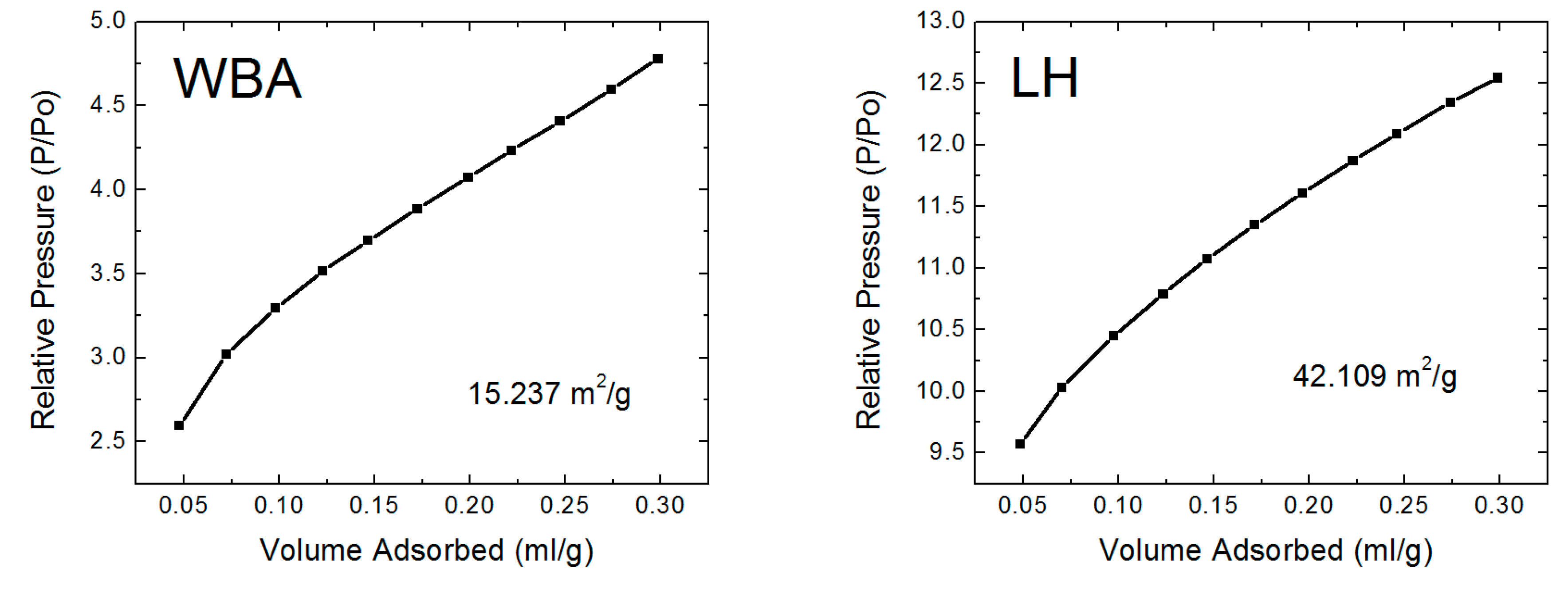
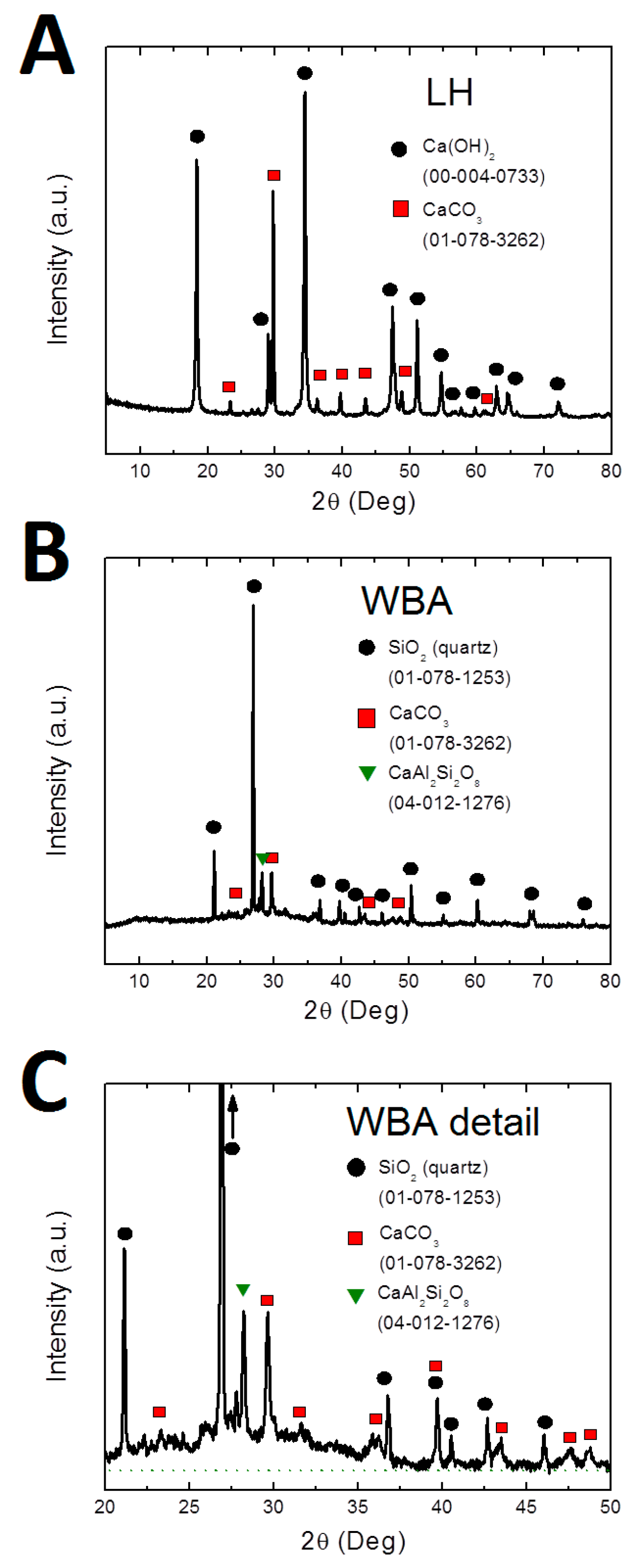
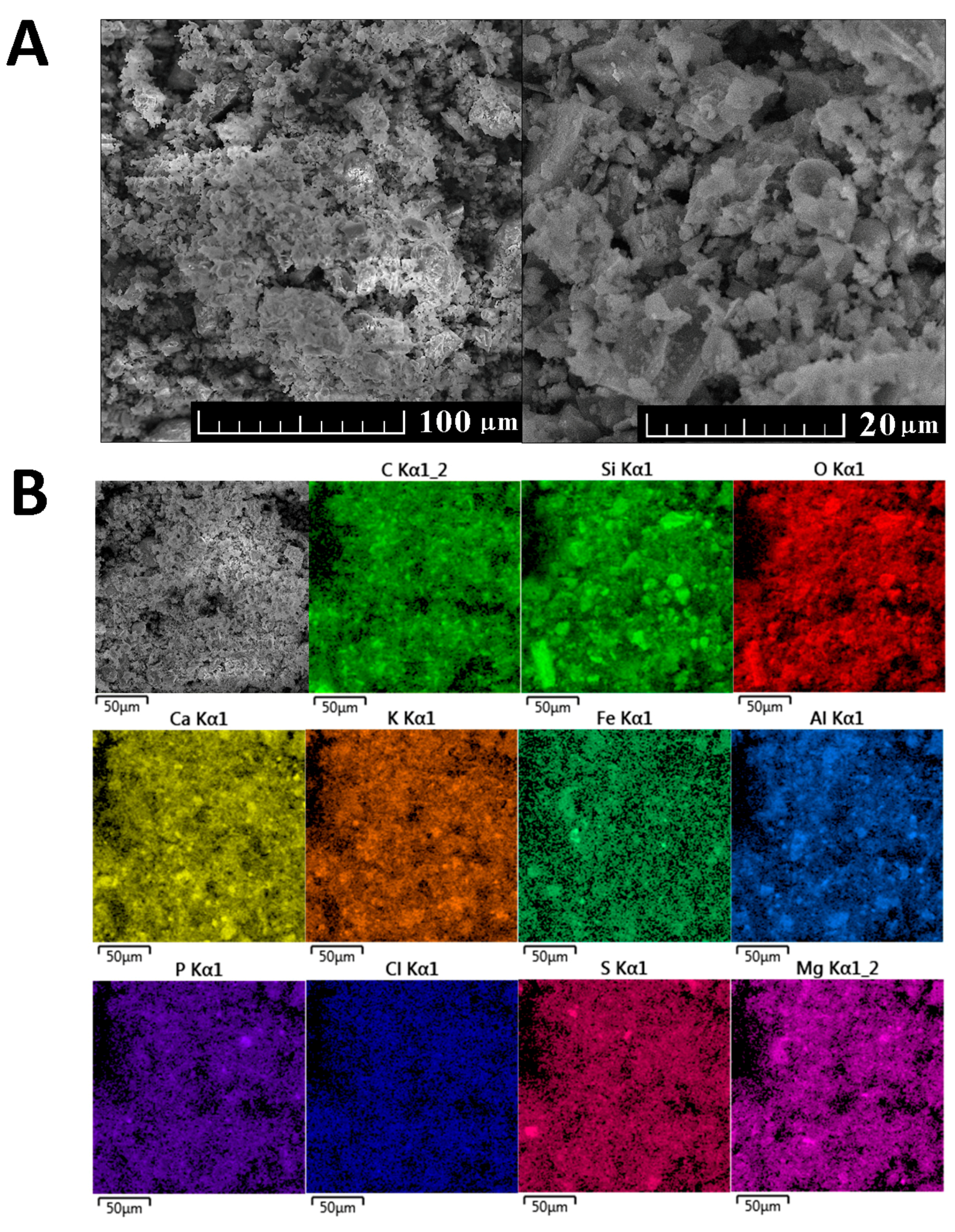

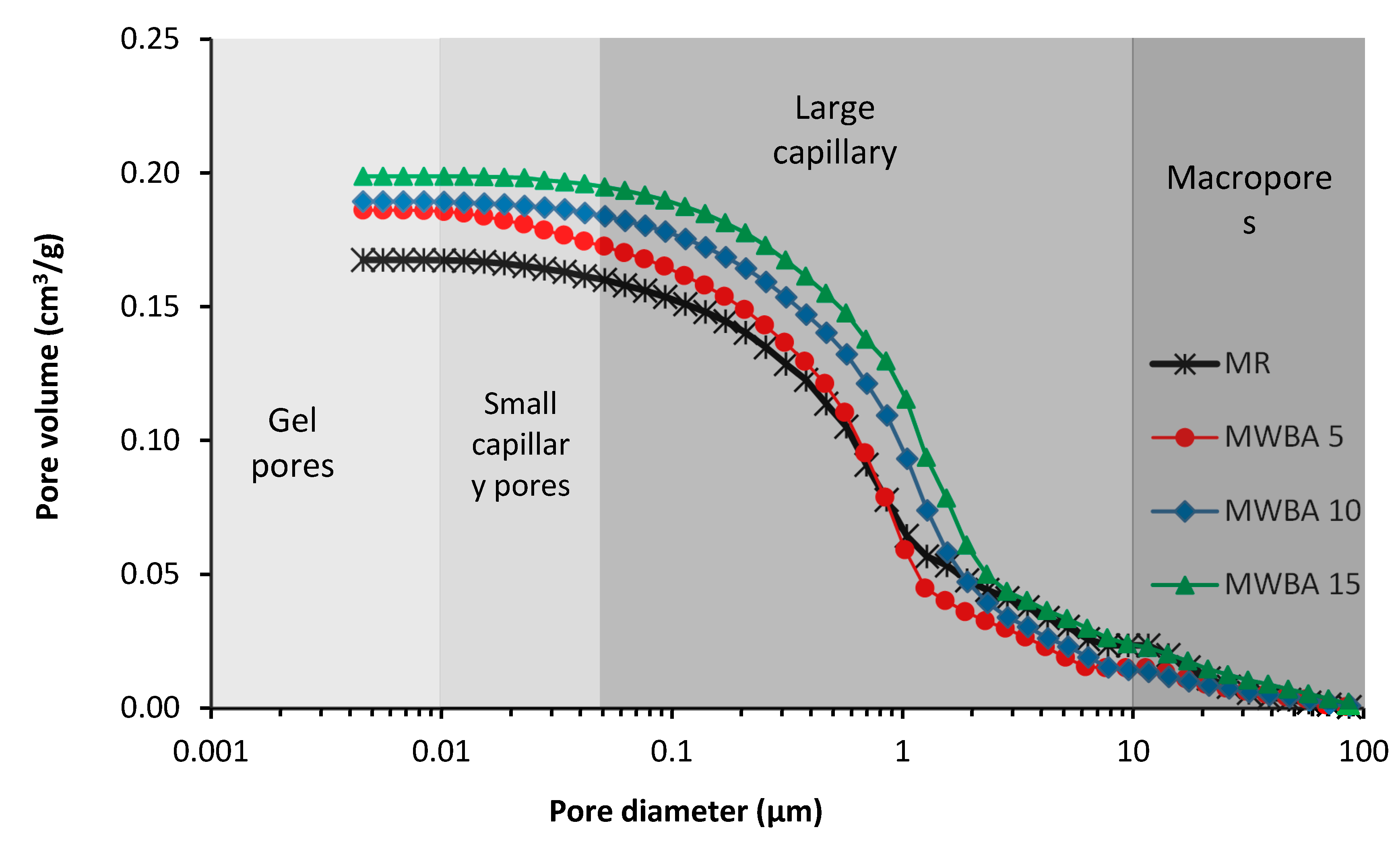
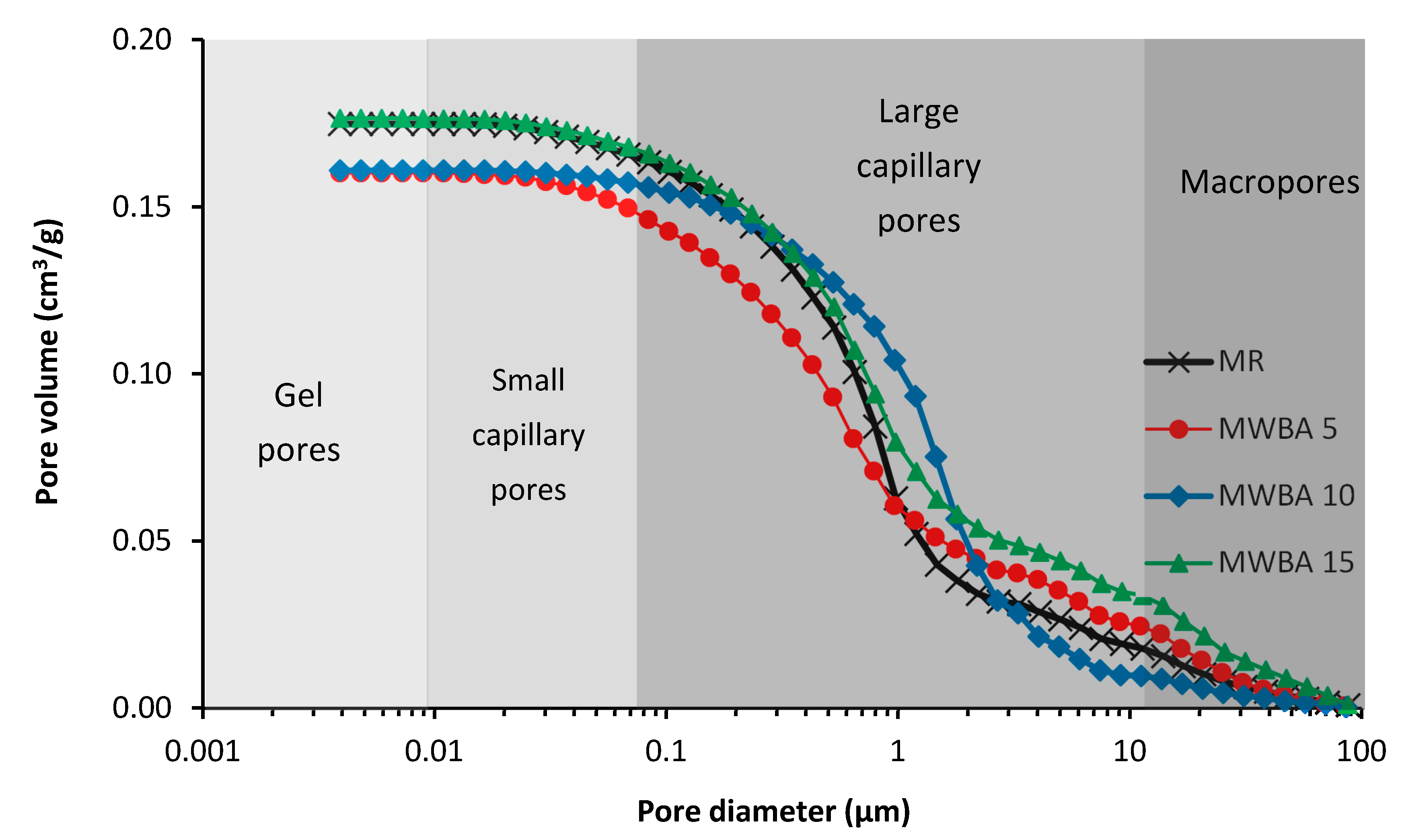
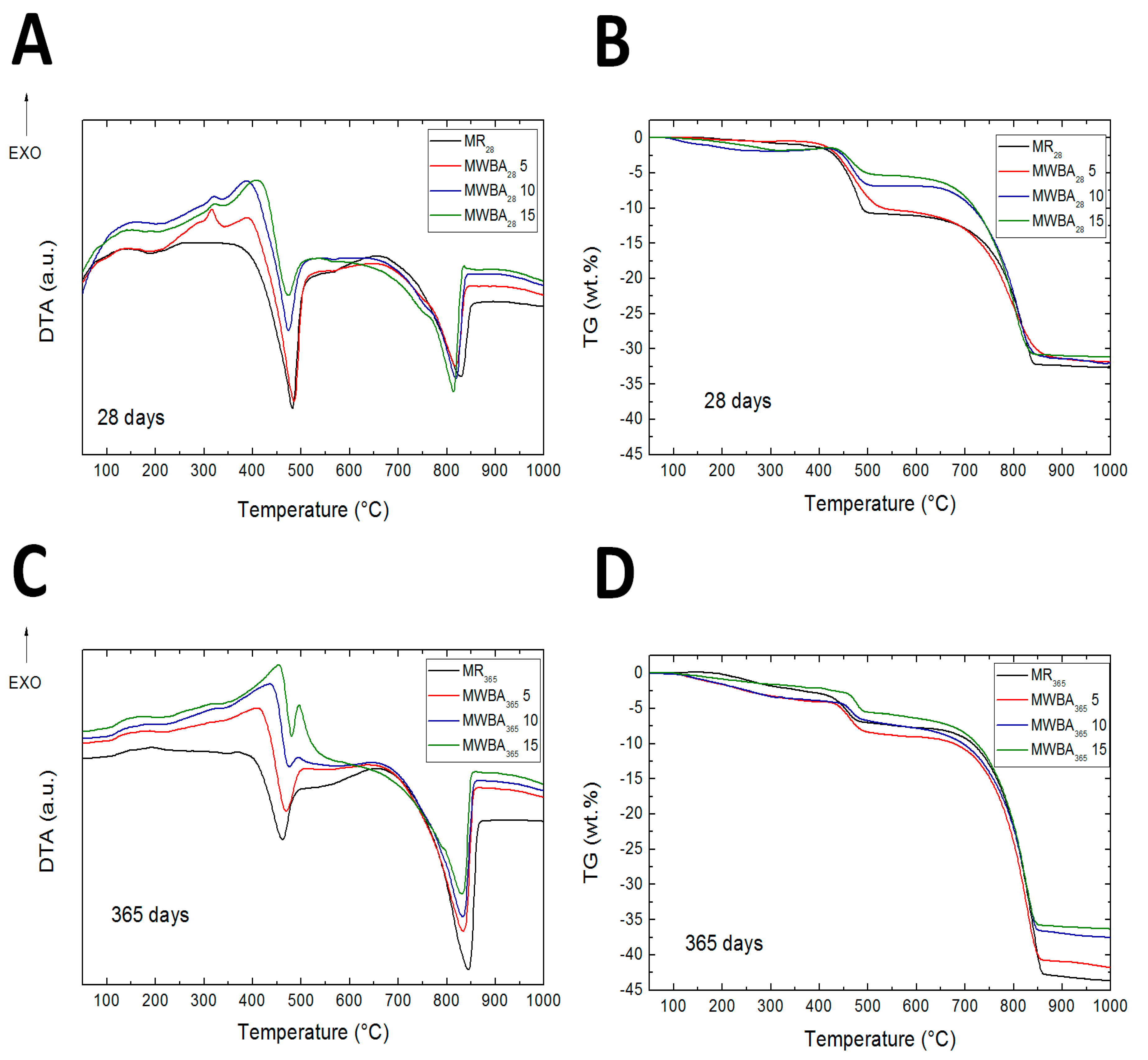
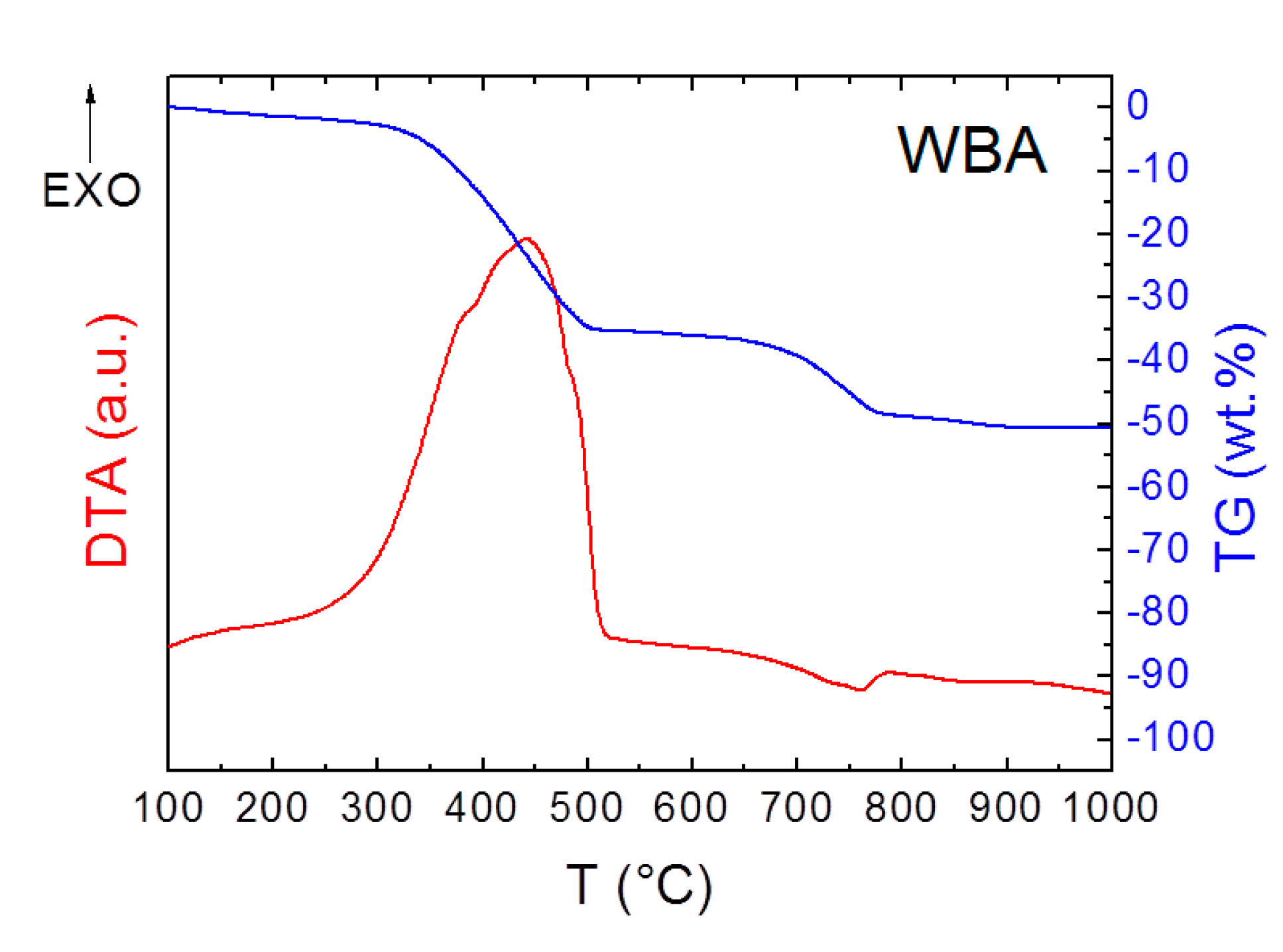
| Mortar Mix | Lime Hydrate | WBA | Silica Sand | Water | w/b (-) |
|---|---|---|---|---|---|
| MR | 1350.0 | - | 3 × 1350 | 1350 | 1.0 |
| MWBA 5 | 1282.5 | 67.5 | 3 × 1350 | 1350 | 1.0 |
| MWBA 10 | 1215.0 | 135.0 | 3 × 1350 | 1350 | 1.0 |
| MWBA 15 | 1147.5 | 202.5 | 3 × 1350 | 1350 | 1.0 |
| Material/Production Process | Energy Consumption (kWh) | CO2 Emission (kg) |
|---|---|---|
| Lime hydrate | ||
| quarrying | 10.3 | 2.5 |
| crushing and grinding | 1.46 | 0.8 |
| calcination | 37.5 | 721 |
| hydration | 13.1 | 7.4 |
| grinding | 22.1 | 12.1 |
| WBA | ||
| grinding | 22.1 | 12.1 |
| Material | Specification | Analysis Range | Key References |
|---|---|---|---|
| Lime hydrate | Product | Mining, grinding, calcination, hydration | [64,65,66,67] |
| WBA | Waste product | Grinding | [68,69,70] |
| Material | Blaine Fineness (m2/kg) | BET Surface Area (m2/kg) | Specific Density (kg/m3) | Powder Density (kg/m3) |
|---|---|---|---|---|
| LH | 2211 | 42,109 | 2210 | 239 |
| WBA | 781 | 15,237 | 2557 | 875 |
| Substance | WBA | LH |
|---|---|---|
| Amount (wt %) | ||
| CuO | 0.01 | - |
| Na2O | 0.92 | - |
| ZnO | 0.13 | - |
| MgO | 3.18 | 0.54 |
| Al2O3 | 10.32 | - |
| BaO | 0.16 | - |
| SiO2 | 45.57 | 0.01 |
| P2O5 | 2.63 | - |
| SO3 | 3.24 | 0.07 |
| SrO | 0.07 | 0.03 |
| Cl | 0.64 | - |
| ZrO2 | 0.04 | - |
| K2O | 7.56 | - |
| CaO | 18.08 | 99.33 |
| TiO2 | 0.82 | - |
| V2O5 | 0.02 | - |
| PbO | 0.02 | - |
| Cr2O3 | 0.02 | - |
| MnO | 1.85 | - |
| Fe2O3 | 4.71 | 0.02 |
| ∑ | 100.00 | 100.00 |
| Material | Flow (mm) |
|---|---|
| MR | 185/180 |
| MWBA 5 | 180/180 |
| MWBA 10 | 220/220 |
| MWBA 15 | 245/250 |
| Material | 28 Day Samples | 365 Day Samples | ||||
|---|---|---|---|---|---|---|
| ρb (kg/m3) | ρs (kg/m3) | ψ (%) | ρb (kg/m3) | ρs (kg/m3) | ψ (%) | |
| MR | 1742 | 2578 | 32.4 | 1766 | 2614 | 32.4 |
| MWBA 5 | 1745 | 2578 | 32.3 | 1773 | 2603 | 31.9 |
| MWBA 10 | 1739 | 2577 | 32.6 | 1772 | 2605 | 31.9 |
| MWBA 15 | 1736 | 2579 | 32.7 | 1761 | 2606 | 32.4 |
| Mortar Type | Cumulative Pore Volume (cm3/g) | Average Pore Diameter (μm) | Threshold Pore Diameter (μm) | Total Porosity (%) |
|---|---|---|---|---|
| MR28 | 0.1674 | 0.960 | 0.835 | 31.3 |
| MR365 | 0.1705 | 0.791 | 1.468 | 30.9 |
| MWBA28 5 | 0.186 | 0.958 | 1.247 | 31.6 |
| MWBA365 5 | 0.1599 | 0.791 | 1.444 | 30.8 |
| MWBA28 10 | 0.1892 | 1.036 | 1.904 | 32.4 |
| MWBA365 10 | 0.1602 | 1.041 | 2.677 | 31.5 |
| MWBA28 15 | 0.1906 | 1.041 | 2.306 | 33.1 |
| MWBA365 15 | 0.1750 | 1.038 | 1.796 | 32.3 |
| Mortar Type | Mass Change (%) | Portlandite Content (wt %) | ||
|---|---|---|---|---|
| 28 Days | 365 Days | 28 Days | 365 Days | |
| MR | 9.3 | 4.2 | 38.21 | 17.25 |
| MWBA 5 | 9.2 | 4.0 | 37.8 | 16.44 |
| MWBA 10 | 5.4 | 2.5 | 22.19 | 10.27 |
| MWBA 15 | 3.7 | 2.4 | 15.20 | 9.87 |
| Material | ff28 (MPa) | ff365 (MPa) | fc28 (MPa) | fc365 (MPa) | Ed28 (GPa) | Ed365 (GPa) | SAI28 (%) | SAI365 (%) |
|---|---|---|---|---|---|---|---|---|
| MR | 0.79 | 0.90 | 1.08 | 2.33 | 2.5 | 2.8 | - | - |
| MWBA 5 | 0.72 | 1.23 | 0.87 | 2.88 | 2.7 | 3.6 | 80.6 | 123.6 |
| MWBA 10 | 0.65 | 1.15 | 0.85 | 2.40 | 2.6 | 3.4 | 78.7 | 103.0 |
| MWBA 15 | 0.61 | 0.89 | 0.81 | 2.12 | 2.4 | 2.9 | 75.0 | 91.0 |
| Material | Aw (kg/(m2∙s1/2)) | wsat (kg/m3) | κ (× 10−7 m2/s) | κ Difference from MR (%) |
|---|---|---|---|---|
| MR | 0.307 | 323.2 | 9.0 | - |
| MWBA 5 | 0.304 | 320.7 | 8.9 | −1.1 |
| MWBA 10 | 0.310 | 325.2 | 9.1 | 1.1 |
| MWBA 15 | 0.321 | 327.2 | 9.6 | 6.7 |
| Dry-Cup | ||||
| Material | δ (× 10−11 s) | D (× 10−6 m2/s) | μ (-) | μ Difference from MR (%) |
| MR | 1.50 | 2.05 | 12.2 | - |
| MWBA 5 | 1.48 | 2.03 | 12.3 | 0.8 |
| MWBA 10 | 1.52 | 2.08 | 12.0 | −1.6 |
| MWBA 15 | 1.62 | 2.21 | 11.3 | −9.8 |
| Wet-cup | ||||
| MR | 1.71 | 2.34 | 10.7 | - |
| MWBA 5 | 1.66 | 2.27 | 11.0 | 2.8 |
| MWBA 10 | 1.79 | 2.45 | 10.2 | −4.7 |
| MWBA 15 | 1.99 | 2.72 | 9.2 | −14.0 |
| Material | λdry (W/(m∙K)) | cvdry (× 106 J/(m3∙K)) | λsat (W/(m∙K)) | cvsat (× 106 J/(m3∙K)) |
|---|---|---|---|---|
| MR | 0.88 | 1.44 | 2.22 | 1.62 |
| MWBA5 | 0.86 | 1.59 | 2.01 | 1.64 |
| MWBA10 | 0.79 | 1.43 | 2.34 | 1.70 |
| MWBA15 | 0.76 | 1.39 | 2.45 | 1.71 |
| Material | Energy Consumption (kWh) | CO2 Emission (kg) |
|---|---|---|
| LH–WBA 5 | 0.8 | 5.9 |
| LH–WBA 10 | 1.6 | 11.8 |
| LH–WBA 15 | 2.4 | 17.6 |
© 2019 by the authors. Licensee MDPI, Basel, Switzerland. This article is an open access article distributed under the terms and conditions of the Creative Commons Attribution (CC BY) license (http://creativecommons.org/licenses/by/4.0/).
Share and Cite
Pavlíková, M.; Zemanová, L.; Pokorný, J.; Záleská, M.; Jankovský, O.; Lojka, M.; Pavlík, Z. Influence of Wood-Based Biomass Ash Admixing on the Structural, Mechanical, Hygric, and Thermal Properties of Air Lime Mortars. Materials 2019, 12, 2227. https://doi.org/10.3390/ma12142227
Pavlíková M, Zemanová L, Pokorný J, Záleská M, Jankovský O, Lojka M, Pavlík Z. Influence of Wood-Based Biomass Ash Admixing on the Structural, Mechanical, Hygric, and Thermal Properties of Air Lime Mortars. Materials. 2019; 12(14):2227. https://doi.org/10.3390/ma12142227
Chicago/Turabian StylePavlíková, Milena, Lucie Zemanová, Jaroslav Pokorný, Martina Záleská, Ondřej Jankovský, Michal Lojka, and Zbyšek Pavlík. 2019. "Influence of Wood-Based Biomass Ash Admixing on the Structural, Mechanical, Hygric, and Thermal Properties of Air Lime Mortars" Materials 12, no. 14: 2227. https://doi.org/10.3390/ma12142227
APA StylePavlíková, M., Zemanová, L., Pokorný, J., Záleská, M., Jankovský, O., Lojka, M., & Pavlík, Z. (2019). Influence of Wood-Based Biomass Ash Admixing on the Structural, Mechanical, Hygric, and Thermal Properties of Air Lime Mortars. Materials, 12(14), 2227. https://doi.org/10.3390/ma12142227









